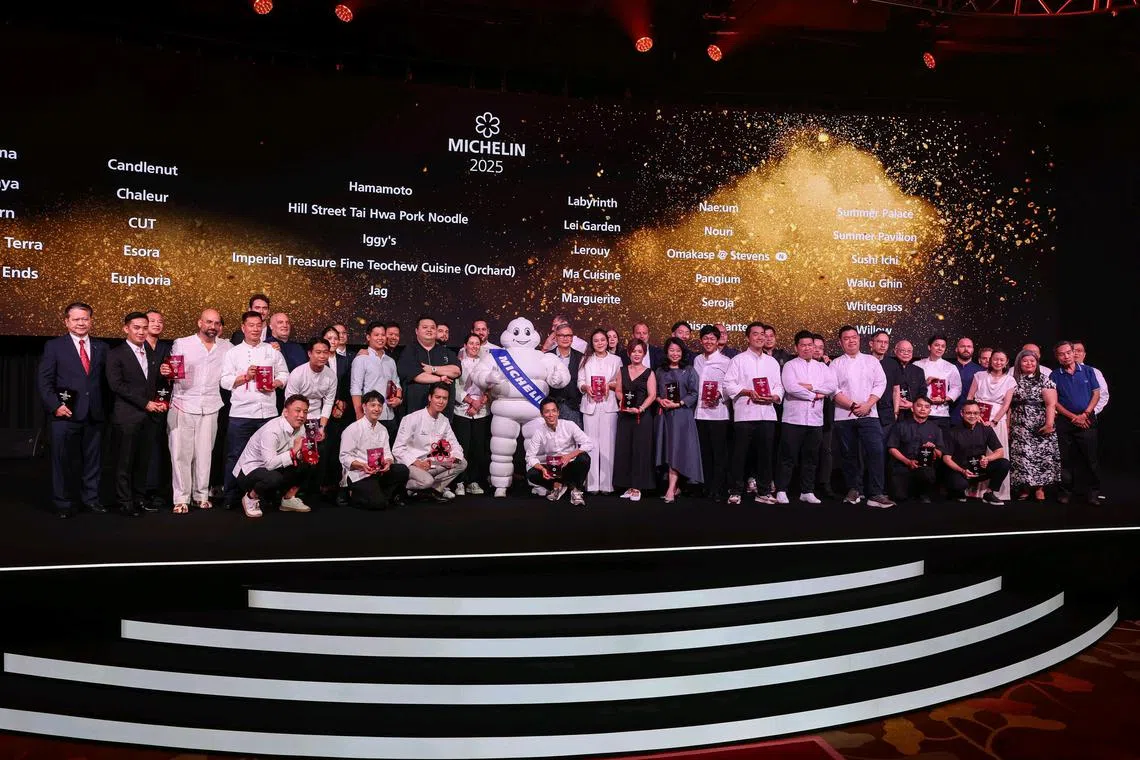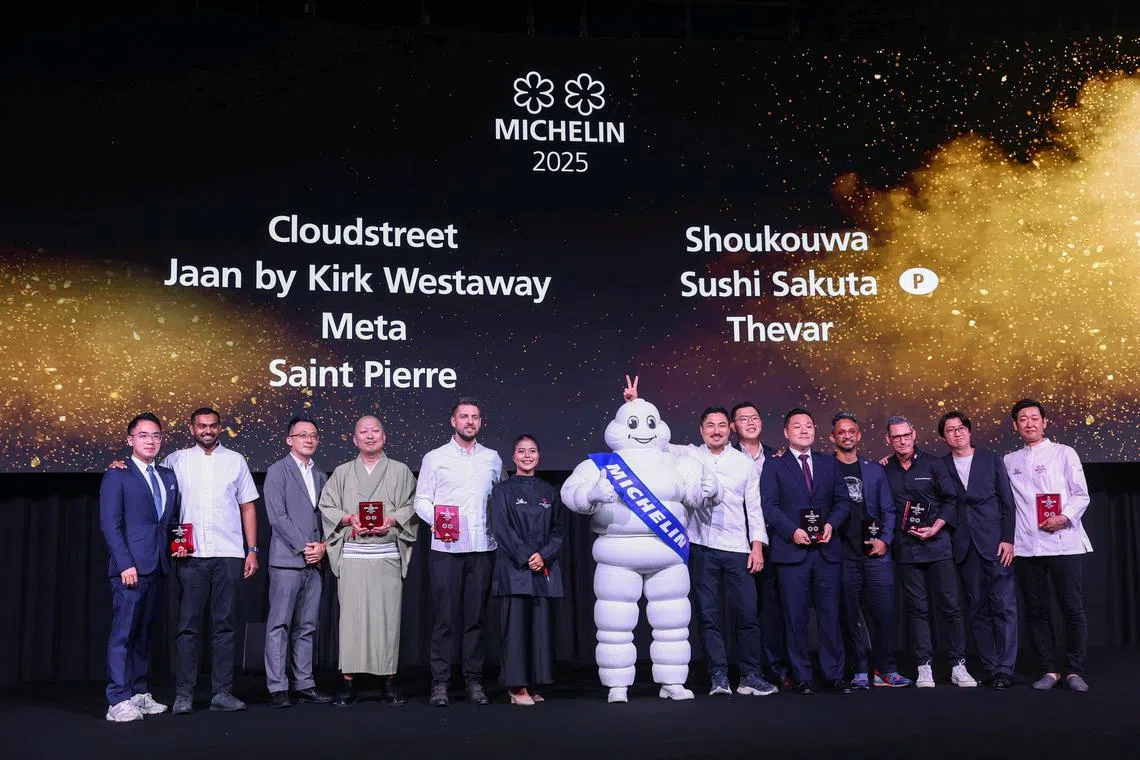Viewpoint
Michelin-restaurant meltdown: 8 one-star closures and what it means for the F&B scene
Sign up now: Get ST's newsletters delivered to your inbox

Representatives of Singapore's one-Michelin-starred restaurants take the stage at the annual award ceremony at Marina Bay Sands, on July 24.
ST PHOTO: BRIAN TEO
Follow topic:
- Singapore's Michelin Guide sees a high turnover of one-star restaurants, with eight closures in 2024, highlighting the unsustainability of chasing stars.
- Restaurants in Singapore face challenges like rising costs, manpower shortages and changing diner preferences amid global economic uncertainty.
- Operators urge relaxed foreign worker quotas and diner understanding of service lapses caused by manpower shortage
AI generated
SINGAPORE – Going up on stage to collect a Michelin star plaque on the night of July 24 must have been bittersweet for the representative of one restaurant. That restaurant is closing soon.
Before the glitzy ceremony at Marina Bay Sands, where the 2025 Michelin Guide Singapore’s starred restaurants were revealed, I looked at the one-, two- and three-starred lists of restaurants going back to 2022, just so I’d have the information handy.
The lists of two- and three-starred restaurants have been pretty stable. The same cannot be said of the one-starred list. It looks like a restaurant graveyard, I remarked to a colleague.
In 2024, the Singapore edition of the French tyre company’s gourmet restaurant guide listed 42 one-starred establishments.
Eight restaurants have closed: Art di Daniele Sperindio, Chef Kang’s, Matera, Oshino, Poise, Shinji at Carlton Hotel, Sommer and Sushi Kimura – although Art is set to re-open.
Ten-year-old Rhubarb in Duxton Hill has rebranded itself and is now the more casual Encore by Rhubarb. That takes it off the 2025 list. Terra Tokyo Italian in Tras Street dropped off the list. One-starred Sushi Sakuta at The Capitol Kempinski Hotel Singapore was promoted to two stars.
Omakase@Stevens was the only addition to the one-starred list.
Out of more than 3,790 restaurants that opened in 2024, Michelin did not find one that was worthy of a star. Fancy that.
Restaurants here had a tough 2024. Some 3,047 food businesses died, an almost 20-year high surpassed only in 2005, which saw 3,352 closures.
The outlook for 2025 looks similarly bleak. Diners are cutting back on spending in Singapore because of global economic uncertainty and the strong Singapore dollar making holidays abroad cheaper. Competition is rife – about 300 new restaurants open every month and about the same number close each month too.
Restaurants are essentially eating themselves.
They are not the only ones grappling with higher operating costs, manpower shortages and diner apathy either.
In the United Kingdom, according to The Guardian newspaper, restaurants and pubs are reeling from increases to employer national insurance contributions and a rise in the national living wage.
In France, people are hit by inflation, making restaurant meals and groceries more expensive, reports Fortune magazine. Bloomberg News says diners in the United States are finding restaurant meals more expensive, as restaurants get hit by rising costs and manpower shortages.
Looking at the list in previous years, and the churn and closures among the list of one-starred establishments in Singapore, it is clear that a Michelin star is no guarantee of success.
As the representatives of the one-starred restaurants took to the stage for a group photo at the ceremony, I wondered how many of them would still be standing at the next Michelin shindig.
Come to think of it, how many two- or three-starred ones too?
Is there coming back from this?

Representatives of the two-Michelin-starred restaurants at the annual ceremony.
ST PHOTO: BRIAN TEO
Stars or sustainability
No chef can be faulted for wanting his restaurant to have Michelin stars. The guide has had 125 years to burnish its reputation. Those anonymous inspectors, always paying for their meals, often making mysterious choices, add to the myth surrounding the guide.
Who is anyone to trample on dreams of stardom?
The pursuit of stars is not a bad thing. In Singapore, that has meant restaurants upping their game, putting more effort into creating unique food offerings, sourcing unusual ingredients, putting together better wine lists and getting serious about good service.
Dining in Singapore is comparable with dining in many big restaurant cities.
But are stars as important as building a sustainable business?
I am not talking about fermenting vegetable scraps into non-alcoholic beverage pairings for a restaurant’s tasting menu.
What I mean is a restaurant that manages to be creative and exciting, that puts out food diners are eager to return for, that generates enough revenue to sustain the owner, chef and employees, and their families.
We all know restaurants like that. These are not places you go to once a year for a special occasion. These are places you pop into after a bad day at work because you know you’ll be taken care of. These are places serving food you can eat a couple of times a week. These are places that will not cause credit card meltdown. They do not have Michelin stars.
So, credit to Rhubarb, which kept its one star for a decade, for taking the plunge. Its more casual reinvention Encore has an a la carte menu and friendlier prices, but continues with classic French flavours and attentive service.
That star must have been so hard to let go of, but restaurants have to evolve with their diners. Also, who’s to say Encore might not earn a star?
Credit to Station by Kotuwa in Boon Tat Street, with its more flexible menu. Diners can be free and easy – a couple of snacks and cocktails before adjourning to another restaurant for dinner; a meal of small plates and a bottle of wine to unwind; a full soup to nuts meal.
Credit to Na Oh at the Hyundai Motor Group Innovation Center in Jurong West, for its intricate, soulful set meals that change with the seasons, priced at $78 a person.
Credit to Ichigo Ichie, the kappo restaurant at Claymore Connect, where I do not have to sit down for a full tasting menu but can order a donabe from the a la carte one, and sake to go with it.
These restaurants know I do not want to take five hours to eat dinner and I do not have the disposable income to pay a mid- or high-three-figure sum every time I go out to eat.
Crippling effect
For my recent feature about the state of play in the Singapore restaurant scene
Pretty much everyone asked the Government to relax the quotas on hiring foreigners. They also asked diners to be more forgiving of service lapses stemming from not having enough staff in the kitchen and on the floor.
The already severe crunch is going to get worse, with local hospitality school Shatec scaling down its operations from April.
It was set up in 1983, and has trained 40,000 people in the hospitality sector. In the 1990s, a diploma was thought of as a “golden ticket” to the hotel and restaurant industries. Now, it is teaching the last batch of students in its pre-employment training programme, and looking to focus on continuing education and training programmes.
Without adequate manpower, restaurants are crippled, one chef told me recently.
So much effort has gone into wooing the Michelin Guide to Singapore, to drawing tourists from all over the world.
But restaurant owners and chefs are scrambling for people willing to work to give the kind of fabulous experience they got into the industry to provide.
They talk of not being able to interview any of the applicants responding to their job ads, because none of them are Singaporean and there is no hope of hiring them. They talk of Singaporean applicants simply not turning up for interviews or slinking off the job on Day One because they cannot handle the pressure.
One hand giveth, the other taketh away.
Will the stars align?

Representatives of Singapore’s three-Michelin-starred restaurants take the stage at the annual ceremony.
ST PHOTO: BRIAN TEO
The evolving preferences of diners, the manpower shortage – these are not new.
Restaurants are doing their part by listening to diners, by trying out new ideas to get more bums on seats. But the manpower crunch stymies them every time.
The frustration is palpable when I talk to owners and chefs. Even at the ceremony, usually a happy occasion, there were glum faces. Enough to make me worry.
If Singapore’s restaurant scene is to maintain its lustre and buzz, the pressing manpower shortage has to be addressed. It is not the only problem, of course, but it’s the biggest one.
Keeping the restaurant scene vibrant is so important. Why else would travellers come here? For the zoo? Already there are 10 fewer one-Michelin-starred restaurants in Singapore to go to. How short does the list have to get before somebody does something?
Is there coming back from this?
Many stars have to align, it would seem.


